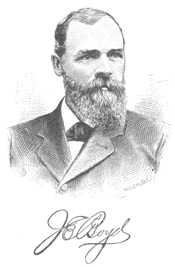Butte, Nebraska actually began on a day in 1890. A man named John Gormley set up a store from a wagon box in a location about a quarter mile north of the town's present site. Boyd County was not yet organized. Soon Mr. Gormley was joined by his partner, John Skirving, and they conducted their business from the wagon while their store was being erected. This was Butte's first building and was used as a Post Office as well as their store. John Gormley was also Butte's first Postmaster. Several more buildings had been built before it became obvious that securing a water source at this site was impossible because of the "hardpan" which lay under the surface soil. Exploration showed that water could be easily found about a quarter of a mile to the south, so the buildings were moved to Butte's present location. The town took its name from the rocky elevations to the south, called the Harvey Buttes.
Within a few months other businesses joined Gormley's store. Bob Ford operated a blacksmith shop across the street from Gormley's, John Shelley had a livery barn, and George Sanders sold feed and flour from the back room of his house. The Sanders house was Butte's first residence. By 1891 the town was growing at a rapid pace. When Boyd County was organized and Butte was declared the temporary County Seat, several businesses which had been located in Mankato, about two and a half miles south of Butte, relocated to Butte and by 1892 Butte had two hotels, five dry goods and grocery stores, three hardwares, one lumber yard, one brick yard, one stone quarry, one feed and flour store, one shoe shop, one furniture store, three livery barns, two blacksmiths, two restaurants, several doctors, a travelling dentist, five lawyers, a barber, and three newspapers, The Gazette, The Free Lance and The Banner. Butte had a good school and three organized church groups who were in the process of building churches. The population at that time was five hundred.
The earliest of settlers came in wagons or covered wagons since there was no other way to get there. Many came by train to towns in Holt County, but from there they had to travel by wagon. A few hardy pioneers whose families were not with them walked from the railroad. Some came in special immigrant trains from states east of the Missouri River. Most of them came to make homes as the countryside did not lend itself to speculation. At first there was no building material for homes and out of necessity these settlers built sod houses or dugouts or a combination of the two. Cottonwood logs were used to some extent by settlers along the river. A little bit of lumber came in from the first, but it was insufficient and not everyone could afford it. The land was broken by walking plows and not all of the settlers had even these. Wives often followed husbands who had gone ahead to stake their claim or build a house.


